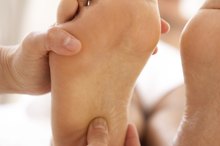Treatment for a Pinched Nerve in a Leg
When suffering from a pinched nerve symptom in the leg, the trick is figuring out whether the nerve is in the leg itself or in the lower back. The leg has only a few major nerves and only a few places where those nerves could be pinched, so accurate diagnosis and thus proper treatment is relatively straightforward. Clinical examination is the most important tool in that regard, and if necessary a nerve test called an EMG can provide additional details.
In the Back
The first and most common location for a pinched nerve is in the back. Radiculopathy refers specifically to a nerve root being impinged right where it comes out of the spine. Typically this causes tingling and/or pain partially or all the way down the leg. If more severe, it may also lead to weakness of muscles controlled by that nerve. The treatment depends on what specifically is pinching the nerve—for example, a herniated disc, arthritis or scar tissue. Physical therapy can often relieve the problem, but sometimes epidural injections are needed for pain relief. Surgery may be needed to definitively solve the problem, particularly if the problem is progressive.
- The first and most common location for a pinched nerve is in the back.
- The treatment depends on what specifically is pinching the nerve—for example, a herniated disc, arthritis or scar tissue.
In the Buttock
Numbness in Feet and Calves While Running
Learn More
Sciatica is the general term for pain that radiates down the back of the leg, and piriformis syndrome is one of the possible causes. It occurs when the piriformis muscle in the middle of the buttock spasms and compresses the large sciatic nerve that runs under it or sometimes through it. Physical therapy is the main treatment. It involves loosening the muscle and its grip on the nerve. Therapy should also correct the underlying issues that led to the spasm. Very rarely, surgical release of the muscle is necessary.
- Sciatica is the general term for pain that radiates down the back of the leg, and piriformis syndrome is one of the possible causes.
- It involves loosening the muscle and its grip on the nerve.
At the Knee
The peroneal nerve, a major branch of the sciatic nerve, wraps around the outside of the knee, just under the skin. Being so superficial, it is prone to being compressed—most commonly by the other knee when your legs are crossed—which typically results in temporary tingling or numbness of the lower leg or foot or even foot weakness. Usually symptoms are self-limited and no treatment is needed. However, if the nerve was pinched for a prolonged period or symptoms do not resolve quickly, there may be actual nerve damage. Again, physical therapy would be the main treatment to address nerve stimulation and strengthening as needed. If you're experiencing foot drop, an orthotic boot or plastic mold may be needed to support the foot.
- The peroneal nerve, a major branch of the sciatic nerve, wraps around the outside of the knee, just under the skin.
- Being so superficial, it is prone to being compressed—most commonly by the other knee when your legs are crossed—which typically results in temporary tingling or numbness of the lower leg or foot or even foot weakness.
At the Ankle
5 Things You Need to Know About Symptoms Of Sciatic Nerve Pain
Learn More
Tarsal tunnel syndrome is the compression of the nerve within the tarsal tunnel on the inside of the ankle. Bones and the overlying connective tissue form this tunnel through which nerves and some tendons travel on their way to the foot. It is very similar to the carpal tunnel syndrome at the wrist. Symptoms can include numbness, tingling, pain, and cramping on the bottom of the foot. Anti-inflammatory drugs can relieve any inflammation in the tunnel that may contribute to the compression, and physical therapy can further relieve the pressure in the tunnel as well as restore normal nerve function. Steroid injections can be of benefit in some cases. Occasionally surgery is required to open the tunnel and relieve the pressure on the nerve.
- Tarsal tunnel syndrome is the compression of the nerve within the tarsal tunnel on the inside of the ankle.
- Occasionally surgery is required to open the tunnel and relieve the pressure on the nerve.
In the Foot
Morton neuroma is a knot of thickened tissue around an irritated nerve, usually on the undersurface of the foot, between the third and fourth toes. Commonly resulting from tight shoes, neuromas develop due to constant pressure or irritation on the forefoot and cause numbness, stinging pain or tingling in the toes. A change of shoes, use of shoe inserts or orthotics, steroid injections, and physical therapy are all potential treatments. Surgery is possible but not usually necessary.
- Morton neuroma is a knot of thickened tissue around an irritated nerve, usually on the undersurface of the foot, between the third and fourth toes.
- Commonly resulting from tight shoes, neuromas develop due to constant pressure or irritation on the forefoot and cause numbness, stinging pain or tingling in the toes.
Related Articles
References
- American Association of Neuromuscular and Electrodiagnostic Medicine: Tarsal Tunnel
- American Academy of Orthopedic Surgeons: Morton's Neuroma
- Therapeutic Programs for Musculoskeletal Disorders: James F. Wyss and Amrish Patel
- Hochman MG, Zilberfarb JL. Nerves in a pinch: imaging of nerve compression syndromes. Radiol Clin North Am. 2004;42(1):221-45. doi:10.1016/S0033-8389(03)00162-3
- NIH National Institute of Neurological Disorders and Stroke. Pinched nerve information page. Updated March 27, 2019.
- AdventHealth Medical Group. Cauda equina syndrome.
- AAOS OrthoInfo. Cervical radiculopathy (pinched nerve). Updated June 2015.
- Dimitrova A, Murchison C, Oken B. Acupuncture for the treatment of peripheral neuropathy: A systematic review and meta-analysis. J Altern Complement Med. 2017;23(3):164-179. doi:10.1089/acm.2016.0155
- Conger A, Cushman DM, Speckman RA, Burnham T, Teramoto M, McCormick ZL. The Effectiveness of Fluoroscopically Guided Cervical Transforaminal Epidural Steroid Injection for the Treatment of Radicular Pain; a Systematic Review and Meta-analysis. Pain Med. 2019 Jun 10. pii: pnz127. doi:10.1093/pm/pnz127 [Epub ahead of print]
- Keating L, Treanor C, Sugrue J, Meldrum D, Bolger C, Doody C. A randomised controlled trial of multimodal physiotherapy versus advice for recent onset, painful cervical radiculopathy - the PACeR trial protocol. BMC Musculoskelet Disord. 2019 Jun 1;20(1):265. doi:10.1186/s12891-019-2639-4
- Ahmad M, Tsang K, Mackenney PJ, Adedapo AO. Tarsal tunnel syndrome: A literature review. Foot Ankle Surg. 2012 Sep;18(3):149-52. doi:10.1016/j.fas.2011.10.007
- Ahmad M, Tsang K, Mackenney PJ, Adedapo AO. Tarsal tunnel syndrome: A literature review. Foot Ankle Surg. 2012 Sep;18(3):149-52. doi:10.1016/j.fas.2011.10.007
- Brown MN, Pearce BS, Trescot AM, Karl HW. (2016) Tibial Nerve Entrapment. In: Trescot A.M. (eds) Peripheral Nerve Entrapments. Springer, Cham doi:10.1007/978-3-319-27482-9_73
Writer Bio
In practice since 2001, Kerrie Reed is a professor of physical medicine and rehabilitation at Rush University Medical Center and a physician at Chicago Sports and Spine. Reed earned her M.D. from the University of Texas and her Bachelor of Arts in English from Duke University. She was first published in "Chicago Athlete" magazine in 2007.






